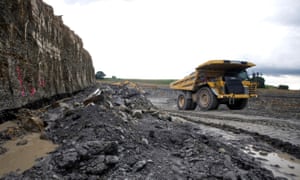Yet-to-be-released forecasts show large decline in sector that Tony Abbott has said is ‘good for humanity’ owing to new greenhouse gas targets taking effect

Coal will be hit hardest by the Abbott government’s new greenhouse gas targets and global climate action – with a 14% cut in the value of coal production in 2030 due to the new Australian target and an 8% cut due to the policies of other countries.
The forecasts for the sector that Tony Abbott has insisted is “good for humanity” and has “a big future as well as a big past” are contained in yet-to-be-released modelling provided to the government as it made the decision to promise that Australia would reduce emissions by between 26% and 28% of 2005 levels by 2030.
The prime minister said when announcing the policy on Tuesday: “We certainly aren’t forecasting the demise of coal. Our policy doesn’t depend upon the demise of coal. In fact, the only way to protect the coal industry is to go with the sorts of policies that we have. That’s why I think our policies are not only good for the environment but very good for jobs.”
The coal forecasts, contained in two sets of modelling done by the leading economist Warwick McKibbin, come as a number of central questions were left unanswered by the government as it announced the target to be taken to the UN conference in Paris in December.
The government argues its target won’t impose large costs on the Australian economy, and Abbott said the emissions reduction fund – which buys greenhouse abatement – would continue to get around $200m a year, or about $2bn over the decade covered by the new target.
But the Australian Industry Group said delivering the new target via the fund would cost at least 50 times more than that – somewhere between $100bn and $250bn.
The government says it will also use yet-to-be-released and uncosted policies on energy efficiency, vehicle efficiency and “safeguards” that in theory could force businesses to buy permits if they exceed certain levels of emissions.
But business says it could afford to do this only if it was allowed to buy cheaper permits overseas. The government has deferred a decision on this issue.
Business groups are privately alarmed at the extreme uncertainty created by a target without clear policy from the Abbott government to attain it. They assume the safeguards will impose costs on their operations but cannot assess what these will be without detail.
The modelling looked at the impact of business uncertainty on the cost of Australia’s climate action and found it had an even bigger impact on the Australian economy than other countries’ climate action.
It found that “the negative impact of policy uncertainty” to Australia’s GDP is around three times larger … than the impact of all international action.
It said this was because “higher perceived risk reduces investment in the energy sector” which increases energy prices and business input costs. Uncertainty, it said, had “a very large impact on investment” and “on real GDP” and significant consequences for investment.
Abbott insisted he had not adopted higher emissions reduction targets because they would have imposed far higher costs to the economy.
The government’s modelling showed that the 26% target would shave between 0.2% and 0.3% from Australian GDP in 2030, but the same modelling found a 35% target would cut only 0.3% to 0.5% and a 45% target would cut between 0.5% and 0.7%. (The modelling looked at the costs of doing no more after the 2020 target was reached, and of cutting by 26% by 2030, by 25% and by 45%.)
Advertisement
Asked why the government had chosen the lower target, given the small additional costs, Abbott cited modelling that showed a 40% reduction would cut 2% of GDP by 2030 “in the order of $40bn”. It is unclear whether the government commissioned separate modelling that came up with markedly different costs.
The modelling, which the government says will be released within a few days, did find that a higher target would have a bigger impact on the coal industry. It showed that a 35% cut in 2030 emissions would reduce coal output in that year by 20%.
Abbott said the new target was “foursquare in the middle” of the pledges comparable economies will take to the UN meeting in Paris in December.
“It’s better than Japan,” Abbott said after gaining the approval of his party room for the new post-2020 goal. “It’s almost the same as New Zealand. It’s a whisker below Canada. It’s a little below Europe. It’s about the same as the United States. It’s vastly better than Korea. Of course, it is unimaginably better than China.”
But conservationists said the target left Australia looking like a laggard – because measured on like-for-like basis, the US had promised cuts of around 41% by 2030, the EU by around 34% based on 2005 levels, Canada of 30% and Japan – struggling with the impact of the Fukushima disaster on its nuclear industry – 25% on 2005 levels. The average of developed nation emission reductions, using the 2005 base year, is about 36% by 2030.
And they said the target failed to contribute Australia’s fair share of the goal to limit global warming to 2C.

